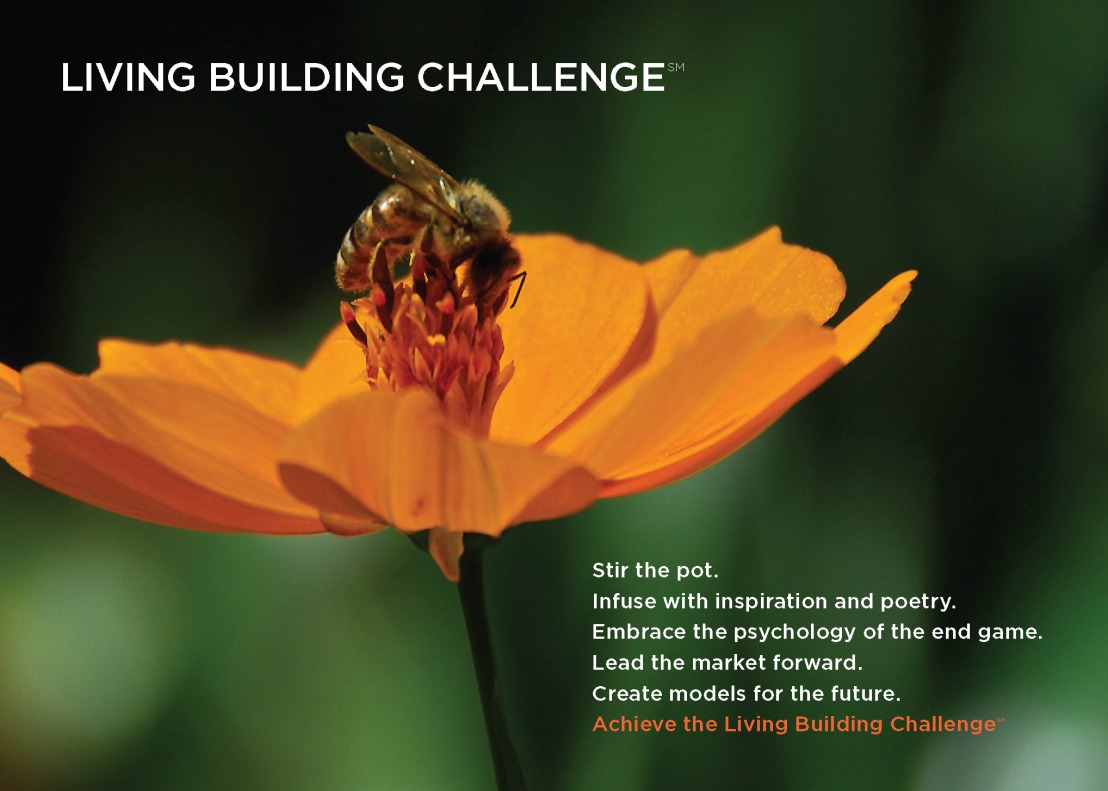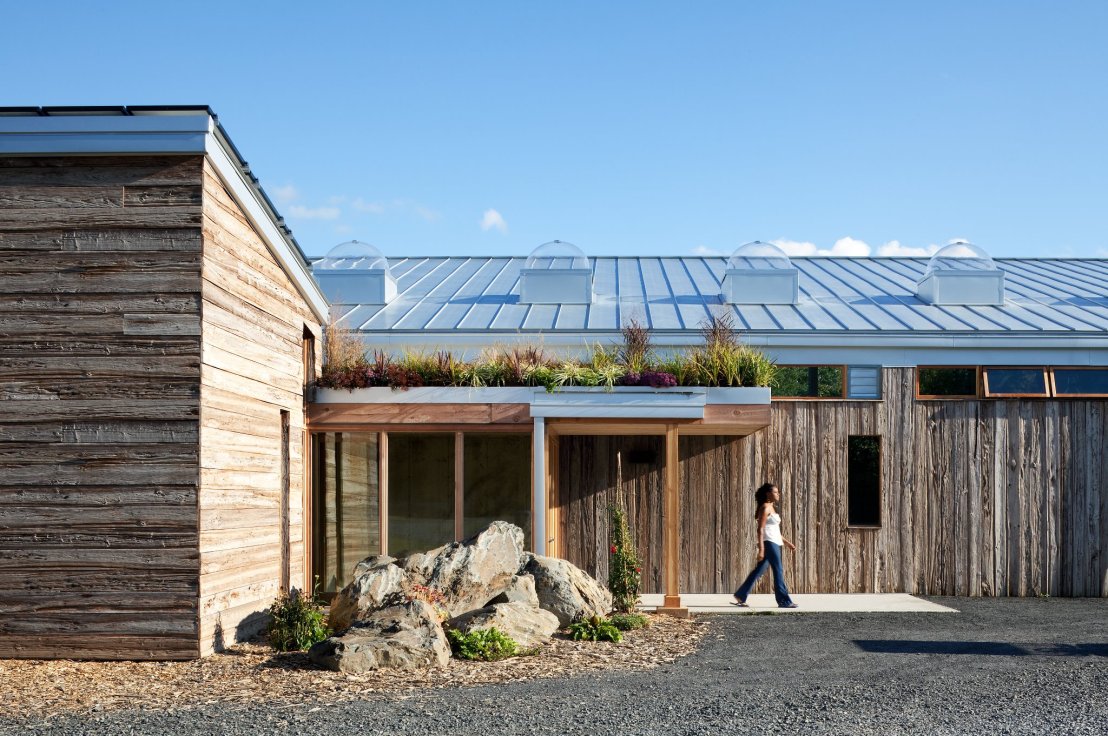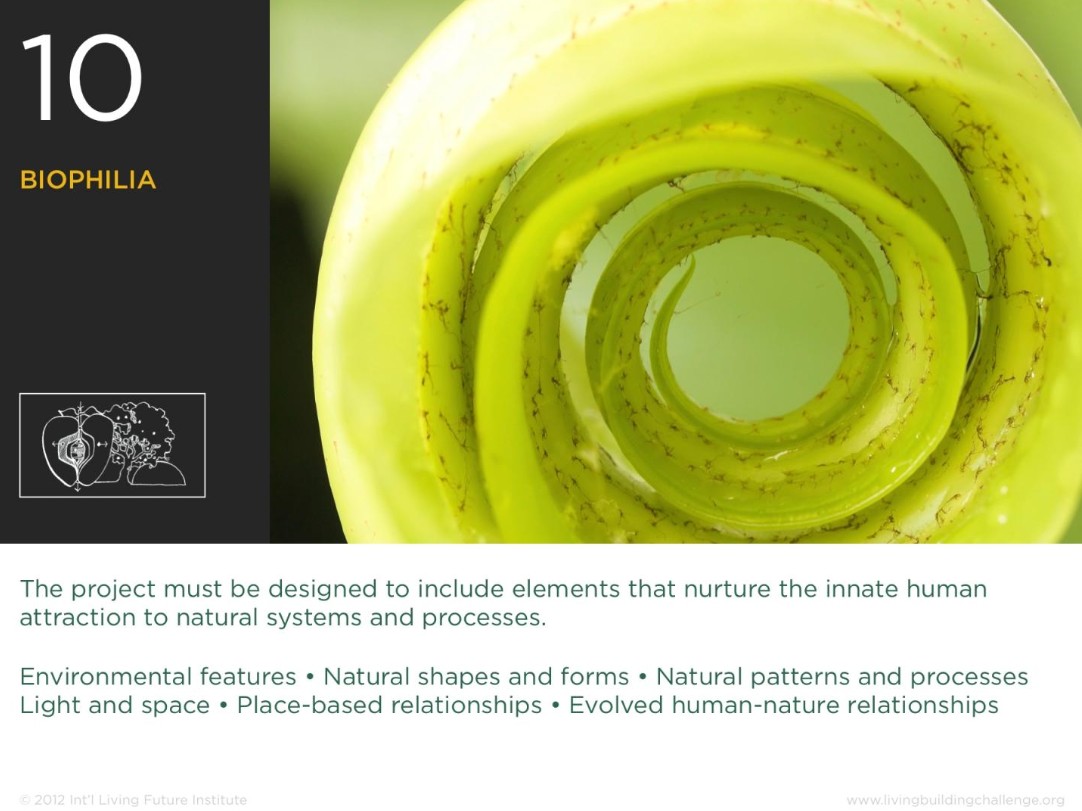Living Building Challenge 2.0 va oltre LEED® Platinum, oltre la Passivhaus, in un concetto di sostenibilità ambientale e sociale all’avanguardia. È una filosofia, uno strumento di tutela e un programma di certificazione che promuove a oggi il sistema più avanzato possibile di misurazione della sostenibilità, dell’ambiente costruito ma non solo. Può essere applicato a tutte le scale, dagli edifici (nuovi o da ristrutturare) a infrastrutture, quartieri e territori.
Living Building Challenge comprende 7 aree di sostenibilità (7 petali …)
- Luogo
- Acqua
- Energia
- Salute
- Materiali
- Equità
- Bellezza
suddivise in 20 “imperativi”, ciascuno dei quali si focalizza su una specifica sfera di influenza.
- Limits to growth
- Urban Agriculture
- Habitat exchange
- Car free living

- Net zero water
- Ecological water flow

- Net zero energy

- Civilized environment
- Healthy air
- Biophilia

- Red list
- Embodied carbon footprint
- Responsible industry
- Appropriate sourcing
- Conservation and reuse

- Human scale and human places
- Democracy and social justice
- Rights to nature

- Beauty and spirit
- Inspiration and education
La certificazione è basata sulle prestazioni effettive dell’edificio misurate in un periodo di 12 mesi consecutivi e non, come nella maggior parte dei sistemi di certificazione, su valori di progetto o modellazione.
Il Living Building Challenge nasce dal Cascadia Green Building Council, un chapter dell’US Green Building Council e del Canada Green Building Council, su iniziativa di Jason f. McLennan e Bob Brekebile di BNIM.
 L’International Living Building Institute™ è stato creato nel maggio 2009 per promuovere e sostenere il sistema di rating; nel 2011 ha cambiato nome in International Living Future Institute™ diventando un’organizzazione a ombrello che raggruppa Living Building Challenge, Cascadia Green Building Challenge, The Natural Step USA ed Ecotone Publishing.
L’International Living Building Institute™ è stato creato nel maggio 2009 per promuovere e sostenere il sistema di rating; nel 2011 ha cambiato nome in International Living Future Institute™ diventando un’organizzazione a ombrello che raggruppa Living Building Challenge, Cascadia Green Building Challenge, The Natural Step USA ed Ecotone Publishing.
Ci sono attualmente più di 100 progetti in corso di certificazione con questo schema.
 L’innovazione del modello sta non solo nel richiedere i massimi livelli di prestazioni resi possibili oggi dalle tecnologie (ad esempio edifici autosufficienti per quanto riguarda la sezione Energia) ma anche nell’inclusione di aspetti sociali e ambientali volti ad una completa armonia del vivere nel costruito (equità, bellezza, biofilia).
L’innovazione del modello sta non solo nel richiedere i massimi livelli di prestazioni resi possibili oggi dalle tecnologie (ad esempio edifici autosufficienti per quanto riguarda la sezione Energia) ma anche nell’inclusione di aspetti sociali e ambientali volti ad una completa armonia del vivere nel costruito (equità, bellezza, biofilia).
Questa settimana il Living Building Challenge ha vinto l’edizione 2012 del Buckminster Fuller Challenge. Living Building Challenge è stato scelto tra i 122 programmi più innovativi e ispiratori del mondo. La sfida era quella di rendere possibile il sogno di Buckminster Fuller, di un mondo “funzionante” al 100% per l’umanità, nel più breve tempo possibile, attraverso la cooperazione spontanea, senza impatti negativi sull’ambiente o svantaggi per chiunque. Tutte le idee partecipanti sono raccolte in un database di iniziative socialmente responsabili chiamato Idea Index che funziona come strumento per educare, connettere ad aiutare a risolvere i problemi.
 Living Building Challenge is …
Living Building Challenge is …
a PHILOSOPHY, ADVOCACY PLATFORM AND CERTIFICATION PROGRAM. Because it defines priorities on both a technical level and as a set of core values, it is engaging the broader building industry in the deep conversations required to truly understand how to solve problems rather than shift them.
an EVOCATIVE GUIDE. By identifying an ideal and positioning that ideal as the indicator of success, the Challenge inspires project teams to reach decisions based on restorative principles instead of searching for ‘least common denominator’ solutions. This approach brings project teams closer to the objectives we are collectively working to achieve.
a BEACON. With a goal to increase awareness, it is tackling critical environmental, social and economic problems, such as: the rise of persistent toxic chemicals; climate change; habitat loss; the collapse of domestic manufacturing; global trade imbalances; urban sprawl; and the lack of community distinctiveness.
a ‘UNIFIED TOOL’. Addressing development at all scales, it can be equally applied to landscape and infrastructure projects; partial renovations and complete building renewals; new building construction; and neighborhood, campus and community design.
a PERFORMANCE-BASED STANDARD. Decidedly not a checklist of best practices, the Challenge leads teams to embrace regional solutions and respond to a number of variables, including climate factors and cultural characteristics.
a VISIONARY PATH TO A RESTORATIVE FUTURE.
perchè il dente di leone?
The Tooth of the Lion: Beauty, Logic and the Institute’s Logo
People often wonder why a common dandelion features prominently in the logo of the International Living Future Institute (the Institute). “Isn’t that a weed?” some have asked. “And what does a lawn menace have to do with green building?”
We are glad you asked and we are happy to explain.
We carefully and intentionally chose the dandelion1 –Taraxacum officinale – as the symbol of the Institute because it stands for many of the same things we do. It is a perfect metaphor. The Institute is committed to creating truly restorative structures and communities, generating global discussion about the need for transformative change in our built environment and flipping conventional wisdom on its head. Our logo’s beautifully stubborn flower helps us convey all that and more. Think it’s a weed? Think again.
The dandelion symbolizes strength. Derived from the French words meaning “lion’s tooth” (used to describe the shape of the leaves), the dandelion’s very name implies natural leadership. Just as the proud lion symbolically leads the animal kingdom, the Institute seeks to guide the human effort toward a restorative future.
The dandelion is collaborative. People think that the dandelion is merely an opportunistic invader. Quite the contrary. With its deep taproot, it has the ability to break up hard earth and bring nutrients up from below the reach of other plants. It literally creates future opportunities for other plants to benefit by growing first where other plants cannot initially grow. It is a good companion for shallower-rooted crops and also attracts pollinating insects, which benefit many other species.
The dandelion endures. This little marvel is a true survivor, challenging our notions of what is and is not desirable in the natural world. We devote incredible amounts of water and energy and petrochemical fertilizer to irrigate the typical American lawn in climates where it would never grow naturally, and then attack the thriving Taraxacum genus with toxic chemicals to rid our landscape of so-called weeds. This is another metaphor for many things in our civilization that we covet, which are actually hurting us and degrading our environment. We need to rethink what we value and the dandelion is a powerful symbol of that paradox.
The dandelion is simple. In the name of progress, humans have a habit of developing complicated technologies that end up being harmful to the planet and its inhabitants. Yet the simplest solutions – such as vegetated roofs, rainwater collection systems or composting toilets – usually deliver the most powerful results. The straightforward nature of the dandelion is similarly commanding: a small flower that can grow just about anywhere.
The dandelion is curative. How could something so packed with vitamins, calcium, potassium, iron, magnesium and zinc be considered a nuisance? The dandelion has been used for a source of nourishment in the form of salads, wine and tea. It has also been shown to have healing properties in the treatment of many medical conditions and has been used as a medicinal plant by many cultures for hundreds of years. Anything with such restorative potential, whether it is a plant or a revolutionary approach to green design, deserves our attention and respect.
The dandelion generates no waste. All parts of the plant may be put to service, just as all systems in a Living Building Challenge project should be models of integrated systems. Whether used for medicinal or culinary purposes, the dandelion’s roots, leaves and buds all offer distinct and often delicious advantages.
The dandelion spreads elegantly. A gentle breeze is all that is needed for the seeds of the dandelion to take flight before settling in nearby soil and beginning a new phase of growth. In the entire natural world there are few methods of spreading the gene pool that are as elegant. Why are there so many delightful photographs of children blowing dandelion seeds? We think there is something primal and beautiful about blowing the seeds off a dandelion – just like we want spreading the word about Living Buildings, Sites and Communities to be so enthralling.
The dandelion is a weed to some people, but to us it represents the possibilities of a restorative future. What, after all, could be more naturally beautiful than a reproductive cycle that relies on the winds of change?
Trim Tab – The magazine for transformational people and design
Trim Tab is the quarterly, online magazine awash with provocative articles, interviews and news on the issues, designs, and people that are truly transforming the built environment. Trim Tab’s mission is to incite deep discussion and inspire the real solutions that our industry must undertake to address the global challenges we face.
(immagini: International Living Future Institute)







Hola. Soy Arquitecto. De Costa Rica. Es bueno ver que a Italia ha llegado el mensaje de Living Building Challenge. Invito a visitar el sitio de Facebook Living Building Challenge Collaborative Costa Rica donde hemos iniciado acciones para compartir este mensaje. Será bueno intercambiar que ocurre e Italia y si existen profesionales e interesados en adoptar esta visión. Saludos.
LikeLike